Bike routes & safety
As the popularity of bicycling continues to grow in Kelowna, so does our network of bike lanes and paths. There are approximately 300 kilometres of on-street bike lanes and 40 km of separated paved multi-use paths. The Okanagan Rail Trail is one example of a paved multi-use pathway that provides a safe, accessible route.
Bike routes in Kelowna
Plan your route with our wayfinding and mapping resources. The Kelowna Bike Map is accessible in online PDF, interactive, and hardcopy versions. Print versions can be obtained from the Kelowna Visitor Centre, Parkinson Recreation Centre, and select bike shops or by submitting a service request under “cycling infrastructure”. The Active by Nature Route Map is a tool to discover routes and pathways to explore and allows filtering by desired distance, mode (e.g. road bike or mountain bike) and other features (e.g. lake view, mountain, orchard).
You can submit a service request if a bike lane needs maintenance.
We’re committed to increasing and improving bike lanes in Kelowna to provide safe, comfortable routes for people of all ages and abilities. People riding bikes and driving cars have the same rights and responsibilities on the road. For the safety of everyone, follow the rules of road to ensure that we all get to our destinations safely.
- Know and obey the rules of the road: people riding bikes have the same rights and duties as people driving vehicles
- Maintain your bike and ensure it’s in good working order
- Be as visible as possible to others
- Learn the skills needed to control your bike
- Ride safely and predictably
* Adapted from BC Bike Sense Manual
Bike lanes & paths
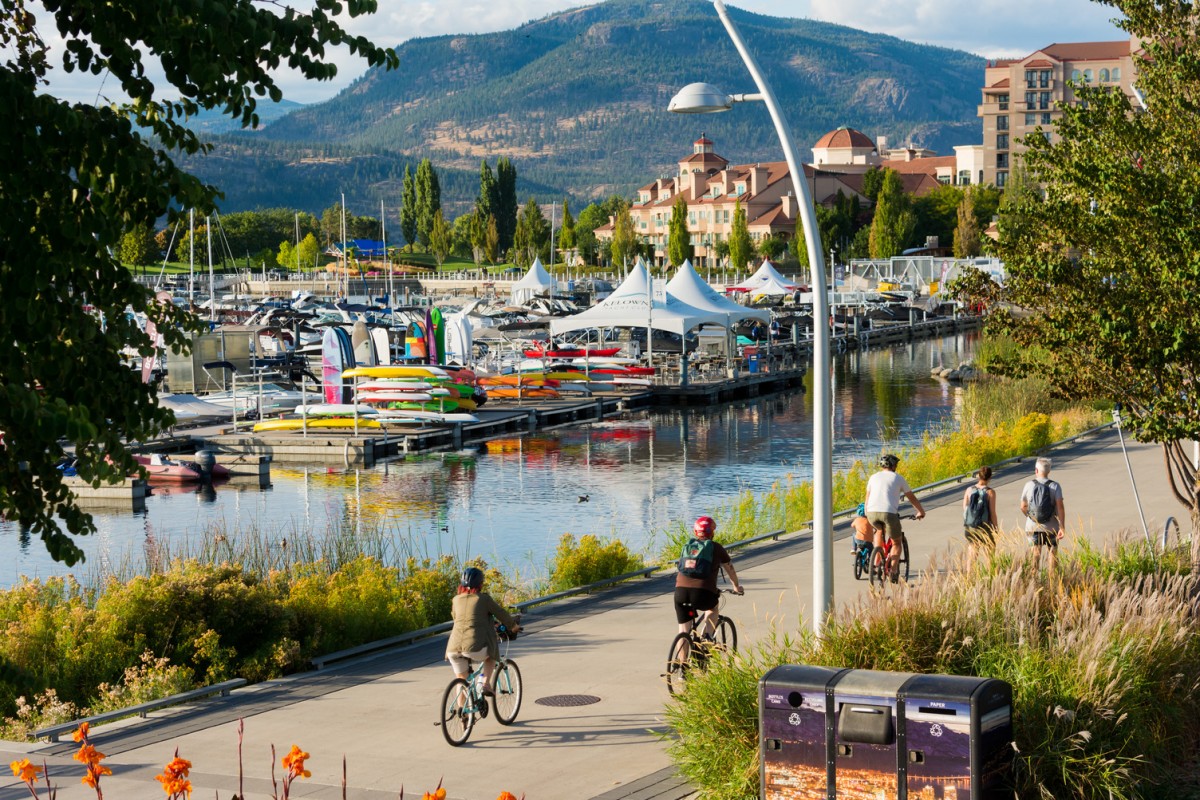 Kelowna has more than 35 kilometres of paved shared-use pathways that are open to a variety of users, including pedestrians, bicyclists, skateboarders, and those using roller skates, e-bikes and e-scooters.
Kelowna has more than 35 kilometres of paved shared-use pathways that are open to a variety of users, including pedestrians, bicyclists, skateboarders, and those using roller skates, e-bikes and e-scooters.
Everyone using pathways should be mindful of other users. Paths marked as shared-use are used for walking, running, and rolling by people of all ages and abilities. Be aware of the rules and etiquette to keep pathways fun and safe for everyone.
- Be alert. Stay aware of your surroundings so that you can hear others who may want to pass.
- Keep right, pass left. Make space for others who need to pass.
- Be predictable. Check for oncoming path users before changing direction or crossing a path.
- Don't block the path. Move to the side when stopping.
- Be visible. Wear lights and reflectors at night so others can see you.
- Control your speed. Need to go fast? Try using the on-road bike lanes.
- Be heard. Alert others before passing but slow down and give plenty of space in case they don't hear you.
- Know and follow the rules of the road. People riding bikes have the same rights and responsibilities as a driver of a vehicle. This means yielding to pedestrians and obeying traffic signs and signals.
Paved shared pathways in Kelowna:
- Waterfront Pathway, downtown
- Okanagan Rail Trail
- Lakeshore Road pathway between Boyce-Gyro Beach and Cook Road
- Houghton Road ATC
- Cawston Avenue pathway between Gordon Drive and Water Street
- Glenmore Road pathway
Separated bike lanes and paths have a physical barrier separating people on bikes from car traffic. It can be either one-way or two-way and can be located vertically at road level or raised to the same level as sidewalks. Examples include the Ethel Street ATC and Abbott Street ATC, which each have a bike lane separate from vehicle traffic and pedestrian sidewalks.
On your bike
- Watch for other people riding bikes
- Be predictable and aware
- Watch for signs and road markings
In your vehicle
- Continue in your lane as normal and follow regular traffic rules
- Don’t cross the barrier separating the cycle track lane
- Don’t stop or park in a bike lane
- Be aware and yield to bikes when turning
- Practice reaching with your right hand to open the driver-side door to look for bikes that may be approaching
Two-way protected bike lanes are on-street bike facilities separated from car traffic and parked cars by a physical barrier. This facility includes two bike lanes located side-by-side on one side of the street, allowing cyclists to travel in both directions. This differs from other scenarios in which there is one bike lane on both sides of the street. The separation of two-way protected lanes allows for a safer, more comfortable bike ride. The new bike lanes on Sutherland Avenue are an example of this type of facility.
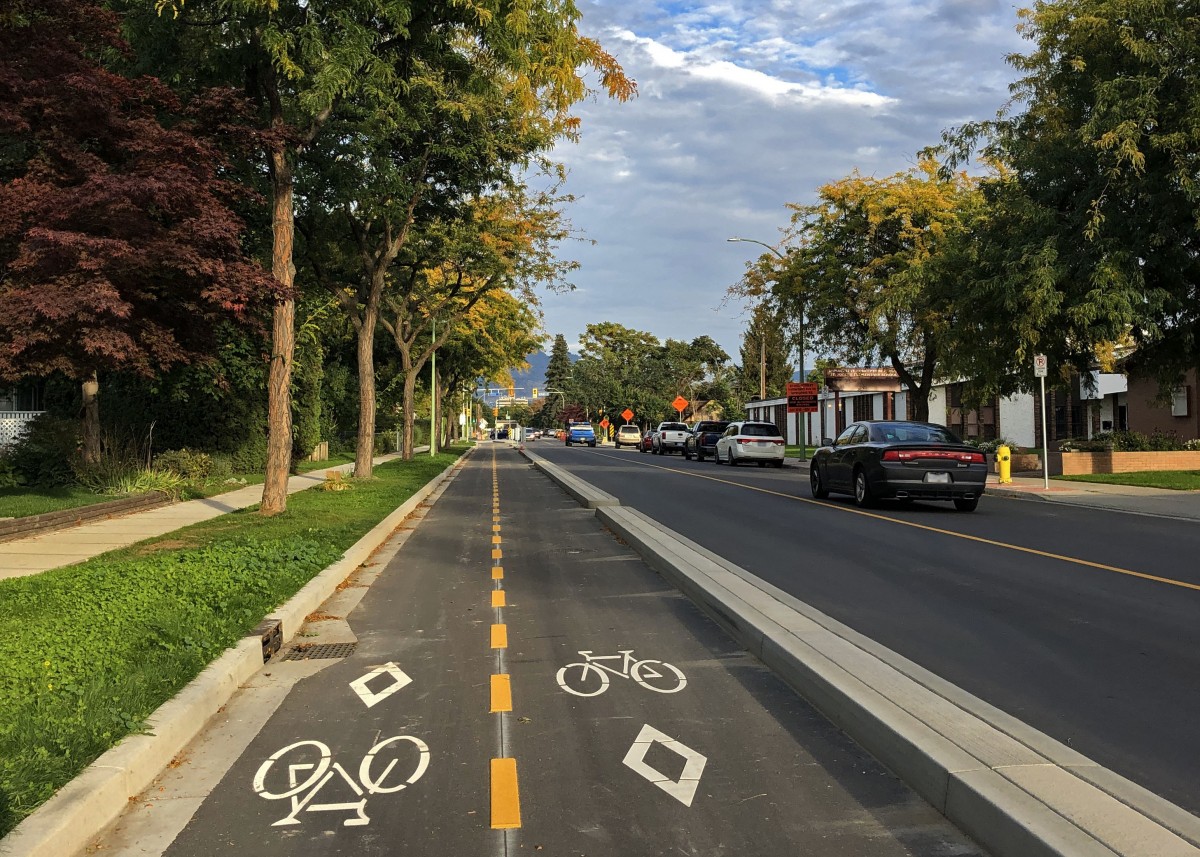
On your bike
- Watch for signs, signals and road markings indicating direction of travel
- Watch for people riding bikes in both directions on one side of the road
- Use green bike turn boxes, where available, to exit the two-way bike lane and turn at intersections
- Know and follow the rules of the road
- Activate bike signals when turning or crossing at intersections
- Yield to pedestrians in crosswalks
- Yield to oncoming bikes when turning
In your vehicle
- Watch for people riding bikes in both directions on one side of the road
- Yield to bikes when turning, even at a red light
- Use caution when turning into and out of driveways
Solid green paint, typically applied at intersections and on corners, remind motorists to give plenty of space and to check for people on bikes prior to making a turn.
On your bike
- Use the green bike lanes to give yourself more separation from vehicles
In your vehicle
- Drive in your lane as normal and follow regular traffic rules
- Don’t cross into solid bike lanes, unless turning into or out of intersecting roads, laneways, driveways and parking when it’s safe to do so
- Don’t stop or park in a bike lane
- Yield to people riding bikes
- Shoulder check when opening your driver-side door to make sure no bikes are approaching. When driving, opening the door with your right hand can help you remember to shoulder check.
Shared lanes are typically found in areas with lower travel speeds, lower traffic volumes or within town centres that don’t have formal bike lanes. Shared lanes provide the space needed to separate cyclists from parking zones and motor vehicle travelling lanes. They also serve as a reminder to motorists that cyclists will be in the same lane.
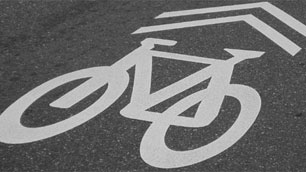
On your bike
- Look for road markings (pictured on the right), which indicate the best place to ride
- Be cautious of and courteous toward motorists
- Follow the rules of the road
- Be predictable
- Leave space between yourself and parked cars in case of opening doors
In your vehicle
- Respect the space required for people on bikes to travel safely (pass people on bikes carefully with more than one meter)
- Remember that people on bikes are allowed on all roadways, and they have the right to use the vehicle travel lane
- Be cautious when parallel parking
- Shoulder check before opening your door
- Practice reaching with your right hand to open the driver-side door to look for bikes that may be approaching
Intersections & crosswalks
There are some changes on Sutherland Avenue between Ethel and Pandosy. When turning, yield to pedestrians and oncoming bikes, watch for turning vehicles, and use the green bike box when available. View detailed intersection directions.
A green bike box in a vehicle lane allows cyclists to wait ahead of vehicles during a red light, giving them priority to move through the intersection when the light turns green. The benefits are that cyclists are more visible and it’s safer to turn at intersections.
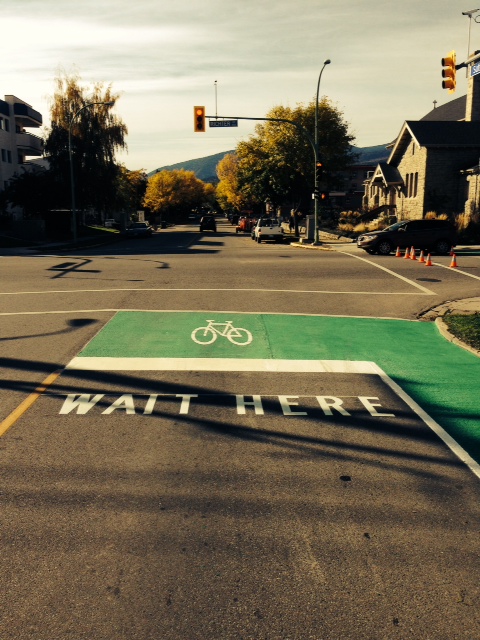
On your bike
Red light
- If turning left, move into the bike box and stop
- If going straight, stop in the green portion of the bike lane or the right side of the bike box
- If turning right, follow regular traffic rules, signal and be aware of other cyclists and vehicles
Green light
- Ride through the intersection as normal, following regular traffic rules
In your vehicle
Red light
- Stop as normal at the stop line, behind the green bike box
- Don’t stop in the green bike box
- Don’t turn right when the light is red
Green light
- Drive through the intersection behind people riding bikes
- When turning right, follow normal traffic rules, signal and watch for oncoming vehicles or bikes
Similar to a pedestrian crossing and its “walk button,” bike signals indicate when it’s safe to cross. Bike signals have a specific button conveniently located on the pole to allow cyclists to stay on their bike while triggering the signal.
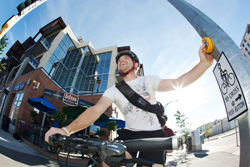
On your bike
- Pay attention to signal changes
- Follow the rules of the road and only cross when it’s permitted and safe to do so
In your vehicle
- As with all intersections, follow regular traffic rules and be cautious of people walking and riding bikes when making right turns
Painted squares at intersections – called “elephant feet” and, in many cases painted green – are found on either side of a crosswalk. These give cyclists a safe area to cross a street without dismounting or block pedestrians from crossing.
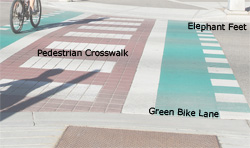
On your bike
- You don’t need to dismount – unlike at a traditional “zebra” print crosswalk
- Follow the rules of the road and only cross when it’s permitted and safe to do so
In your vehicle
- Follow regular traffic rules and be aware that people may ride through the intersection
The same vehicle detection system that recognizes when a car is at an intersection is now able to detect you and your bike, helping to trigger the green light without you having to push the walk button or wait for a vehicle.
On your bike
- Ride up to the intersection as you normally would, stopping at the stop line within the bike lane or turning lane
- Wait for the signal to change to green - the system does the rest




